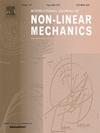Partially invariant solution with an arbitrary surface of blow-up for the gas dynamics equations admitting pressure translation
IF 2.8
3区 工程技术
Q2 MECHANICS
International Journal of Non-Linear Mechanics
Pub Date : 2024-09-17
DOI:10.1016/j.ijnonlinmec.2024.104904
引用次数: 0
Abstract
We applied a method of symmetry reduction to the gas dynamics equations with a special form of the equation of state. This equation of state is a pressure represented as the sum of a density and an entropy functions. The symmetry Lie algebra of the system is 12-dimensional. One, two and three-dimensional subalgebras were considered. In this article, four-dimensional subalgebras are considered for the first time. Specifically, invariants are calculated for 50 four-dimensional subalgebras. Using invariants of one of the subalgebras, a symmetry reduction of the original system is calculated. The reduced system is a partially invariant submodel because one gas-dynamic function cannot be expressed in terms of the invariants. The submodel leads to two families of exact solutions, one of which describes the isochoric motion of the media, and the other solution specifies an arbitrary blow-up surface. For the first family of solutions, the particle trajectories are parabolas or rays; for the second family of solutions, the particles move along cubic parabolas or straight lines. From each point of the blow-up surface, particles fly out at different speeds and end up on a straight line at any other fixed moment in time. A description of the motion of particles for each family of solutions is given.

允许压力平移的气体动力学方程的部分不变解与任意吹胀面
我们将对称性还原法应用于具有特殊形式状态方程的气体动力学方程。该状态方程是以密度函数和熵函数之和表示的压力。系统的对称李代数为 12 维。考虑了一维、二维和三维子代数。本文首次考虑了四维子代数。具体来说,计算了 50 个四维子代数的不变式。利用其中一个子代数的不变式,计算出原始系统的对称性还原。缩减后的系统是一个部分不变的子模型,因为一个气体动力函数无法用不变式来表示。子模型导致两个精确解系列,其中一个描述了介质的等速运动,另一个则指定了一个任意炸开面。对于第一个解系列,粒子轨迹是抛物线或射线;对于第二个解系列,粒子沿立方抛物线或直线运动。粒子从爆炸面上的每一点以不同的速度飞出,并在时间的任何其他固定时刻以一条直线结束。本文给出了每个解系的粒子运动描述。
本文章由计算机程序翻译,如有差异,请以英文原文为准。
求助全文
约1分钟内获得全文
求助全文
来源期刊
CiteScore
5.50
自引率
9.40%
发文量
192
审稿时长
67 days
期刊介绍:
The International Journal of Non-Linear Mechanics provides a specific medium for dissemination of high-quality research results in the various areas of theoretical, applied, and experimental mechanics of solids, fluids, structures, and systems where the phenomena are inherently non-linear.
The journal brings together original results in non-linear problems in elasticity, plasticity, dynamics, vibrations, wave-propagation, rheology, fluid-structure interaction systems, stability, biomechanics, micro- and nano-structures, materials, metamaterials, and in other diverse areas.
Papers may be analytical, computational or experimental in nature. Treatments of non-linear differential equations wherein solutions and properties of solutions are emphasized but physical aspects are not adequately relevant, will not be considered for possible publication. Both deterministic and stochastic approaches are fostered. Contributions pertaining to both established and emerging fields are encouraged.

 求助内容:
求助内容: 应助结果提醒方式:
应助结果提醒方式:


